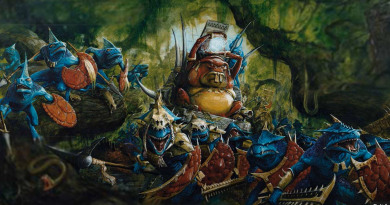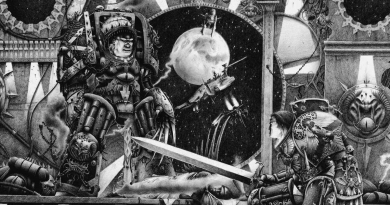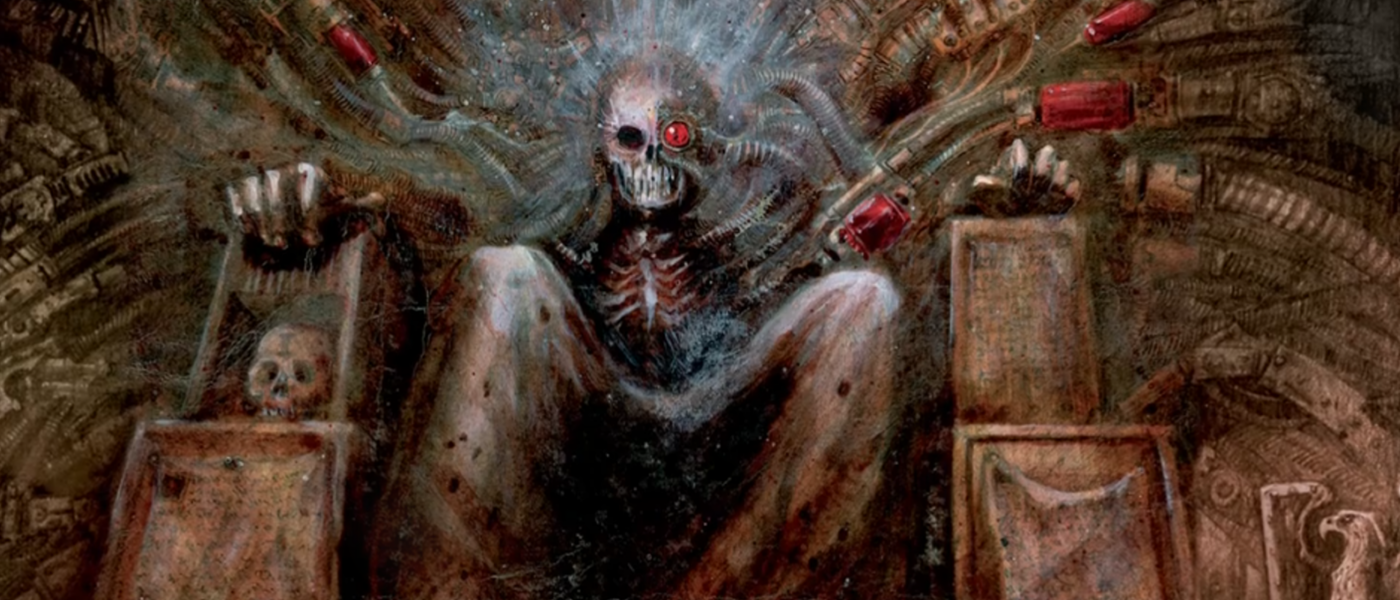Warhammer Video Game Lore Part 1
THERE IS NO HOPE, ONLY STRUGGLE
Warhammer is a franchise of tabletop games, novels, video games, and more, with two major settings: Warhammer Fantasy and Warhammer 40,000 (Warhammer 40k). Each setting has a rich lore that spans thousands of years, with deep narratives involving countless factions, characters, and conflicts. Here’s a brief overview of both settings’ lore:
WARHAMMER FANTASY:
Warhammer Fantasy is set in a dark, gritty, and often brutal medieval-style world. Its lore is deeply rooted in themes of chaos, war, and magic, drawing inspiration from myth, folklore, and European history. The world is inhabited by various races and factions, each with its own distinct culture, history, and motivations.
Key Factions:
- The Empire: A human nation modeled after the Holy Roman Empire, constantly under siege from internal and external threats.
- High Elves: An ancient and highly advanced race with an affinity for magic and a proud culture.
- Dark Elves: A twisted version of the High Elves, they are cruel, sadistic, and live for warfare and slavery.
- Dwarfs: Stalwart, honor-bound warriors with a deep hatred for Greenskins (Orcs and Goblins) and a love of craftsmanship.
- Greenskins (Orcs and Goblins): Brutal and barbaric, the Greenskins are driven by their desire for war and destruction.
- Chaos: The major existential threat to the world, consisting of Chaos Gods and their followers who seek to corrupt and consume everything.
- Undead: Led by powerful necromancers and vampire lords, they raise armies of the dead to serve their dark purposes.
- Skaven: A race of evil rat-men that live in the underground tunnels and caverns, plotting to overthrow the surface world.
The central conflict in Warhammer Fantasy revolves around the constant battle between order and the encroaching forces of Chaos. The Chaos Gods, such as Khorne, Nurgle, Tzeentch, and Slaanesh, try to corrupt the world, with mortals and other factions fighting to resist their influence.
WARHAMMER 40,000 (WARHAMMER 40K):
Warhammer 40k is set in a dystopian future, 38,000 years from now, where humanity is on the brink of extinction, and the galaxy is wracked by eternal war. The tone is one of grim darkness, where the future is bleak, hope is rare, and survival is a constant struggle. The lore of 40k is known for being incredibly detailed and expansive, covering millennia of history.
Key Factions:
- The Imperium of Man: A vast, authoritarian empire ruled by the immortal Emperor, who is worshipped as a god. Humanity is beset by enemies on all sides, from alien threats to heretics within.
- Space Marines: Elite, genetically engineered super-soldiers who serve as humanity’s greatest defenders. Divided into various Chapters, each with its own culture, history, and combat style.
- Chaos Space Marines: Traitor Space Marines who turned to the dark powers of the Chaos Gods during the Horus Heresy, a massive civil war that nearly destroyed the Imperium.
- Chaos: As in Warhammer Fantasy, the Chaos Gods and their legions of daemons and mortal followers seek to corrupt the galaxy, spreading madness and destruction.
- Eldar (Aeldari): An ancient and once-great race of space-faring elves, now in decline after the catastrophic birth of the Chaos God Slaanesh.
- Orks: A violent and primitive race that lives for battle and war, led by warlords known as Warbosses.
- Tyranids: A terrifying, all-consuming alien species that devours entire planets to sustain their endless hunger.
- Necrons: An ancient, robotic race that once ruled the galaxy before going into stasis. Now, they awaken to reclaim their lost dominion.
- Tau Empire: A relatively young race, technologically advanced and idealistic, promoting a philosophy called the “Greater Good,” though they are often at odds with the other factions.
KEY THEMES IN WARHAMMER 40K:
- The Imperium’s Decay: The Imperium is a crumbling, stagnant empire, ruled by dogma and superstition. Its people suffer under the yoke of a brutal, theocratic government that suppresses knowledge and innovation.
- The Warp and Chaos: The Warp is a parallel dimension of raw emotion and psychic energy, from which the Chaos Gods draw their power. Psykers (psychically gifted individuals) are vital to the Imperium but also pose a constant risk of being corrupted by Chaos.
- The Horus Heresy: A defining event in 40k history, where Warmaster Horus, once the Emperor’s favored son, led a massive rebellion against the Imperium, resulting in a civil war that left the galaxy in ruins and the Emperor mortally wounded.
- Xenos Threats: Alien species like the Tyranids, Orks, and Necrons constantly threaten humanity’s existence, and the Imperium wages war on all fronts to prevent their advance.
Both settings are filled with tragedy, heroism, and complex characters, making the Warhammer universe a rich source of stories and gameplay possibilities. Whether it’s the noble but doomed struggle of the Empire against Chaos in Warhammer Fantasy or the eternal war for survival in the grim darkness of Warhammer 40k, the lore is a tapestry of epic conflict, intricate politics, and moral ambiguity.
The overarching message of the Warhammer universe, particularly in Warhammer 40,000 (Warhammer 40k), is one of grimdark, a term coined to describe a setting where the future is bleak, hope is fleeting, and humanity is locked in a state of constant warfare. The narrative conveys several profound and often nihilistic themes, interwoven with commentary on power, corruption, faith, and the cyclical nature of conflict. Below are some of the central messages and themes within the Warhammer universe:
1. THE FUTILITY AND INEVITABILITY OF WAR
Warhammer’s title itself emphasizes the centrality of war to its universe. Both Warhammer Fantasy and Warhammer 40k are settings where war is endless, inevitable, and consuming. The battles fought are not for progress or noble causes but for survival, dominance, or annihilation. In Warhammer 40k especially, there is no peace—only an eternity of war, a sentiment often summed up in the iconic phrase: “In the grim darkness of the far future, there is only war.”
This reflects the grim reality that conflict is inescapable, and even the mightiest forces are ultimately locked in a zero-sum game where victories are pyrrhic and defeats catastrophic. No faction can ever truly achieve lasting peace, and any hope of ending the conflict is either delusional or fleeting.
2. THE CORRUPTION OF POWER
Power, whether in the hands of humans, gods, or alien species, inevitably leads to corruption. The Emperor of Mankind, the central figure of Warhammer 40k, sought to unify humanity under a single, enlightened banner, but his empire devolved into a theocratic, authoritarian regime obsessed with dogma and control. His dream of a rational, secular human empire was consumed by fanaticism, corruption, and endless warfare.
The Chaos Gods, who embody various aspects of human nature—war, desire, ambition, and decay—are another manifestation of how power and influence can corrupt. They are born from the excesses of mortal emotions and desires and ultimately twist and corrupt anyone who seeks their favor. Even the most noble and idealistic individuals can fall prey to their influence, illustrating that the pursuit of power often leads to damnation.
3. THE FRAGILITY OF CIVILIZATION
Both in Warhammer Fantasy and Warhammer 40k, civilizations are always on the brink of collapse. In Warhammer Fantasy, the Empire is constantly besieged by Chaos, Greenskins, Undead, and internal strife. In Warhammer 40k, the Imperium of Man is a crumbling, overstretched empire that is only barely holding off its enemies, often through brute force and brutal suppression.
This theme reflects the fragility of human endeavors and institutions. Even the grandest civilizations can fall due to external threats, internal decay, or corruption. The Imperium of Man, for example, is a decaying husk of the Emperor’s vision, held together by fear, ignorance, and violence. The inability of civilizations to achieve lasting stability or peace speaks to the inevitable decline of all human institutions.
4. THE TYRANNY OF FAITH AND DOGMA
The role of faith and religion is a central theme, particularly in Warhammer 40k, where the Imperium of Man is ruled by a theocratic government that worships the Emperor as a god. Ironically, the Emperor rejected religion and faith during his life, but after his near-death, his followers turned him into the central figure of an oppressive, superstitious regime.
This theme reflects how institutions and ideologies can become warped over time. Even noble ideas, when placed in the hands of corrupt or zealous individuals, can become tools of oppression and tyranny. The Ecclesiarchy (the religious arm of the Imperium) enforces strict control over the populace through fear and ignorance, often punishing those who seek knowledge or question the state.
The Chaos Gods, too, represent how faith and devotion can be twisted. Mortals who turn to Chaos often believe they are gaining power, but in reality, they are being consumed and destroyed by the very forces they worship.
5. THE TRAGIC FALL OF HEROES
The Warhammer universe is filled with stories of heroes who ultimately fall—either to corruption, madness, or death. Whether it is Horus, the Emperor’s beloved son who turned against him in the Horus Heresy, or Archaon, the Everchosen in Warhammer Fantasy, who leads the forces of Chaos to destroy the world, the universe is filled with tragic figures who are undone by their ambition, pride, or despair.
This theme emphasizes the fragility of greatness and the idea that even the most powerful or virtuous figures are not immune to the darker forces at play. No hero in Warhammer is truly without flaw, and the universe repeatedly demonstrates that even the noblest intentions can lead to ruin.
6. HUMANITY’S STRUGGLE FOR SURVIVAL
In Warhammer 40k, humanity is constantly beset by alien threats like the Tyranids, Necrons, and Orks, as well as the insidious influence of Chaos. The Imperium’s vast armies, such as the Space Marines and the Imperial Guard, are in a constant state of war just to ensure humanity’s continued existence.
The survival of humanity is not about thriving, but simply enduring in a hostile galaxy. There is little room for innovation, enlightenment, or improvement—just the brutal reality of clinging to existence. This reflects the theme of survival at all costs, where the ends justify the means and the sacrifices made are often cruel and merciless.
7. THE INESCAPABILITY OF CHAOS
Chaos in the Warhammer universe represents the unpredictability of the human condition. In Warhammer 40k, Chaos is the literal embodiment of human emotion, ambition, and excess. The Chaos Gods—Khorne, Tzeentch, Slaanesh, and Nurgle—are manifestations of rage, change, pleasure, and decay, respectively, feeding off mortal emotions.
Chaos reflects the inescapable darkness within all sentient beings. No matter how hard one might try to resist, Chaos is always lurking in the shadows, ready to corrupt, twist, or destroy. It’s an ever-present reminder that evil and madness are intrinsic to the nature of existence, making it impossible to eliminate or defeat permanently.
8. THE CYCLICAL NATURE OF HISTORY
In both Warhammer Fantasy and 40k, history repeats itself. In Warhammer 40k, the Horus Heresy is an echo of previous galactic civil wars, and the constant conflict among the factions ensures that history never truly moves forward. The rise and fall of empires, the betrayals of brothers, and the eternal struggle between order and chaos are recurring patterns that reinforce the idea that history is cyclical.
This theme underscores the pessimistic notion that there is no escape from the cycles of war, betrayal, and decline. The universe is locked in an endless loop of destruction, and every moment of progress is undone by the next catastrophe.
THE CENTRAL MESSAGE: THERE IS NO HOPE, ONLY STRUGGLE
In essence, the overlying message of the Warhammer universe is grim and nihilistic: hope is an illusion, war is endless, and power only leads to corruption. It is a universe where moral ambiguity reigns supreme, and even the best intentions lead to tragedy. There are no true heroes, only survivors—and survival itself often comes at a terrible cost.
In both Warhammer Fantasy and Warhammer 40k, the grimdark tone serves as a reflection of the darker aspects of human nature: our propensity for violence, our susceptibility to corruption, and our endless cycles of conflict. The universe is a harsh mirror that shows the consequences of unchecked power, fanaticism, and the relentless pursuit of dominance.

Warhammer Video Game Lore Part 2
The Old Ones In the Warhammer universe, the Old Ones are a mysterious, ancient race whose influence shaped much of

Warhammer Video Game Lore Part 3
And Then, The Emporer The God-Emperor of Mankind is one of the most central and enigmatic figures in the lore
